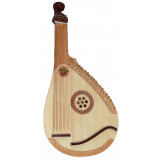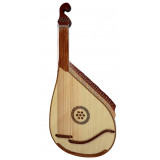Voice of Ukraine
From a musical perspective, the bandura unifies acoustic principles of both the lute and the harp. This produces a sound that is both emphatic and gentle, resembling that of a harpsichord, but with a wider range of dynamics and tonal control. A precursor to the bandura was the kobza, a three- to eight-string instrument mentioned in Greek literature of the 6th century. During the Middle Ages it was prominent in eastern European courts, where it was used to accompany singing and dancing. Additional strings were added to the kobza in the 14th or 15th century, when it became known as the bandura, but the term kobza remains a synonym for bandura. By the 15th century the bandura had been adopted by kobzari, professional musicians who used the instrument as an accompaniment for epic ballads (dumy) that recounted the exploits of the Ukrainian Cossacks. It is often described as the voice of Ukraine.
Types
There are different banduras in concert use. The Kyiv bandura (Chernihivka), which has 55 to 64 strings tuned chromatically, is mass produced and is commonly played in concerts. The classical bandura, tuned diatonically with some 20 strings and wooden pegs, is more refined. The Kharkiv bandura, which is tuned diatonically or chromatically with a single string mechanism and 34 to 65 strings, is not well known, but the Ukrainian Bandurist Chorus has adopted it as their instrument of choice because of its great technical versatility. The more popular Chernihiv bandura is placed in the lap of the bandura player (banduryst) at an angle to the body. The melody is played with the right hand, the accompaniment with the left. In the Kharkiv (Zinkiv) method the bandura is placed in the performer's lap parallel to the body, the left hand reaches over the obychaika to play on the prystrunky, and the right hand plays on the bunty.
Main parts
The bandura has an oval wooden body, a short, fretless neck attached to the soundboard in an off-centre position, 4 to 8 bass strings running from the neck of the instrument to the body, and 30 or more (sometimes more than 60) chromatically tuned treble strings stretched over the soundboard. The body (koriak) of the bandura is usually made from sycamore, cherry, maple, or red willow. The treble nut (obychaika) and pin collar (strunnyk) are made from maple or beech, and the sound board (deka) from spruce. In the modern bandura steel strings are used, the lower ones being wound with copper, brass, or bronze. Until the 20th century wooden turning pegs were used, but these have been replaced by metal pins for greater tonal stability.
Buy banduras in Musician.UA
You can buy banduras in our stores. It is also possible to place an order in the online shop. Delivery is carried out all over Ukraine. Thanks to the wide assortment, everyone will find a suitable product for themselves. You can always count on professional advice and assistance. We care about the quality of service and do everything we can to make sure you are satisfied with your purchase.

 ARTURIA Instruments
ARTURIA Instruments
 Drums for Therapy
Drums for Therapy  Harps
Harps
 Lyres
Lyres
 Didgeridoo
Didgeridoo
 Sound Processing
Sound Processing
 Mixing Consoles
Mixing Consoles
 Vinyl Players
Vinyl Players
 Phono Correctors
Phono Correctors
 Karaoke
Karaoke
 Stands and Holders
Stands and Holders
 Trolleys
Trolleys
 Computers, Electronics
Computers, Electronics



